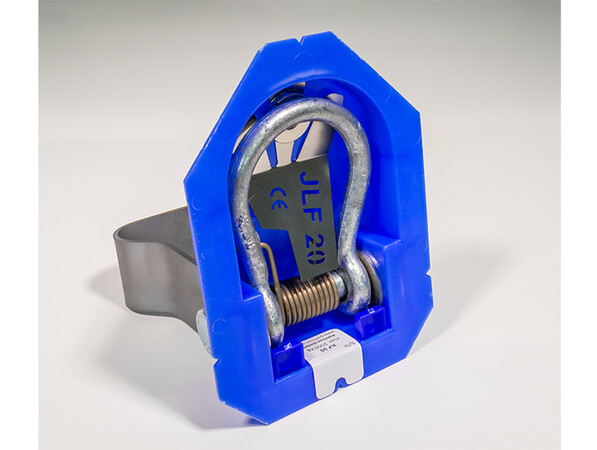Innovative lift shaft anchor
The JFL lift shaft anchor from PohlCon is an anchor point embedded in concrete, designed for heavy loads. It is intended to make working in the lift shaft more efficient and convenient.
Installation or maintenance work in lift shafts calls for reliable attachment solutions. After all, these involve measures that often take place at great heights with heavy loads. PohlCon’s JLF lift shaft anchor, which forms part of its Jordahl product family, was developed to facilitate easy and thus time-saving use when working in the lift shaft. From its headquarters in Berlin, the company operates internationally as a construction industry supplier and provides numerous products related to buildings, currently in 13 product categories.
The main components, the bracket anchor and steel shackle, are attached in the housing: as a result, the slender steel shackle, flush with the ceiling, does not require complicated extraction when being used. Instead, the system has a novel magnetic spring lock, which is activated by pressure on a clearly visible trigger plate, for example, with the aid of a metal bolt.
After the work has been completed, the shackle can simply be pushed back to its starting position. This makes fast, temporary suspension of heavy loads possible, such as protective equipment, spare parts or suspended lift cars.
Two versions for different load requirements
 Pressure on the innovative trigger plate causes the steel shackle, flush with ceiling, to fold out. Photo: © PohlCon
Pressure on the innovative trigger plate causes the steel shackle, flush with ceiling, to fold out. Photo: © PohlConThe lift shaft anchor will initially be available in Germany and Switzerland in the two versions JLF 20 and 40 with the corresponding suspended load levels. The colour of the plastic housings in blue (20 kN) and red (40 kN), familiar to specialists, also makes reliable distinction from afar easy.
The 130 or 190 mm installation depths of the bracket anchor means it can be used for secure and permanent connection in concrete in ceilings from a thickness of 150 mm (JLF 20). Both types are designed for centric tensile loads. Consequently, they are suitable for transverse tensile loading of ± 5°.
Ready-to-install components
After corresponding positioning, the lift shaft anchor is nailed to the wooden formwork in the ceiling with the aid of the nail holes for installation and the ceiling is then concreted as usual. During the subsequent removal of the formwork, the cover is normally also removed and alternatively can be pulled off manually via the integrated opening in the cover of the housing.
Both JLF types are delivered as ready-to-install components and are licensed according to the European Technical Assessment (ETA 21/1071) for heavy loads. The housing cover comes with a QR code for maximum convenience during installation. The fitter can digitally retrieve the installation instructions with the code.
More information: pohlcon.com


























Write a comment